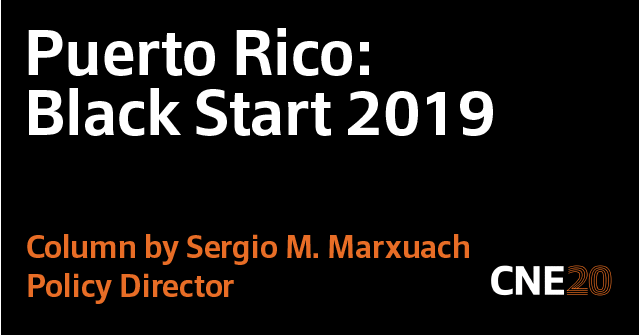
Policy Director
SHARE

Hurricane Maria devastated Puerto Rico’s energy system. After the storm, the island essentially has had to re-activate its energy system from the equivalent of a system-wide “blackstart”, which is the technical term for restarting an energy system from a complete shutdown.
At the same time, the energy sector world-wide is rapidly changing as new technologies come online and challenge the existing 100-year old model of generating, transmitting, and distributing energy to various classes of customers with different needs. Puerto Rico should take advantage of this synchronicity—the almost total destruction of its energy system and the technological advances in this sector—to upgrade its ankylosed electric system to 21st century standards. In other words, we should use the current blackstart-like situation to make a quantitative jump, instead of just restoring its energy system to its pre-Maria status.
In order to successfully make the transition to a new business model for the energy sector, it will be necessary to develop a new energy vision, amend several laws and regulations, upgrade transmission and distribution systems and encourage the efficient use of energy by end customers. This is a tall order, but fortunately resources abound to guide policymakers, regulators and utilities in this process.
The first step … a new vision
The first step in this complicated pathway is developing a new vision for the Puerto Rico energy sector. Charting this vision requires thinking beyond the confines of Puerto Rico, but with a clear understanding of the island’s limitations and challenges. In addition, new legislation will be needed to mandate the implementation of that vision and to set clear targets for regulators regarding environmental objectives, renewable portfolio standards, energy-efficiency goals, demand response and peak load management.
Regulation models will also have to evolve from long-term planning cycles to more proactive supervision regarding the efficient deployment of new resources and more dynamic oversight of the growing number of stakeholders in the energy sector. To accomplish these objectives, regulators will need to shift to performance-based regulation and set transparent accountability metrics, as well as incentives (and penalties) to achieve policy objectives.
New tariff structures
New tariff structures need to be designed to send the right price signals to both generators and customers, promote energy efficiency, manage baseload and peak demand, encourage the transition to bi-directional interaction between grid operators and customers deploying distributed energy resources and to establish block and time-of-use rates to encourage efficiency. In addition, new building design standards, access to finance energy-conservation retrofitting, and the adoption of consumption-reduction technology for households should also be widely encouraged.
Energy Generation
Large generation facilities with 30-plus-year investment recovery cycles are increasingly a thing of the past. On the other hand, building smaller, highly efficient traditional generation units, widely-distributed across the service areas to support baseload demand is quickly becoming both technologically feasible and cost-effective. This model, coupled with increased renewable generation/storage solutions to provide reserves, other ancillary services and additional load at peak times, is not only efficient, but can provide extremely reliable service, with lower outage rates, and lower costs for all customers.
Grid designs will also have to evolve to efficiently and reliably incorporate distributed generation, grid-scale and customer-owned battery storage units to allow the storage of electricity when not required for immediate use and thereby promote and enhance the value of environment-friendly intermittent generation resources. In addition, the rapidly growing market for electric cars creates the potential for additional demand, presumably at off-peak hours, therefore stabilizing baseload requirements that are forecast to decline in the coming years. Electric cars are also a storage solution that could discharge energy back to the grid when that charge has other more valuable uses. However, this would also entail making capital improvements outside the traditional utility paradigm, given that electric cars would need widely available and accessible charging stations throughout the island.
Flexibility
Finally, given the foreseeable effects of rapid and impending climate change, the grid of the 21st century has to allow for the incorporation of micro and mini-grids that can connect and disconnect from the main grid as needed to ensure critical infrastructure has adequate back-up in the event of natural or man-made disasters, to protect isolated communities from prolonged service outages, and to limit health and environmental impacts.
These are some of the themes we will be exploring during the “Future of Energy Conference”, convened by the Center for a New Economy for the first quarter of 2019. In addition, we will analyze the role of academic institutions in Puerto Rico’s energy transformation; the need to attract new capital at competitive terms; as well as research and development opportunities and the economic development impact of redesigning Puerto Rico’s energy sector.
This column was originally published in El Nuevo Día on June 17th, 2018
